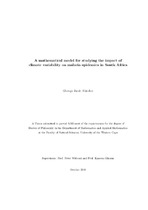A mathematical model for studying the impact of climate variability on malaria epidemics in South Africa
Abstract
Malaria is most prevalent in tropical climates, where there are sufficient rainfall
for mosquitoes to breed and conducive temperatures for both the mosquito and
protozoa to live. A slight change in temperature can drastically affect the lifespan
and patterns of mosquitoes, and moreover, the protozoan itself can only
survive in a certain temperature range. With higher temperatures, mosquitoes
can mature faster, and thus have more time to spread the disease. The malaria
parasite also matures more quickly at warmer temperatures. However, if temperatures
become too high, neither mosquitoes nor the malaria pathogen can
survive. In addition, stagnant water is also a major contributor to the spread
of malaria, since most mosquito species breed in small pools of water. The correct
amount and distribution of rainfall increases the possible breeding sites
for mosquito larvae, which eventually results in more vectors to spread the disease.
With little rainfall, there are few places for the mosquitoes to breed. For
these reasons, and in order to control mosquito population, it is important to examine the weather parameters such as temperature and rainfall which are
imperative in determining the disease epidemics. Accurate seasonal climate
forecasts of these variables, together with malaria models should be able to
drive an early warning system in endemic regions. These models can also be
used to evaluate the possible change in regions under climate change scenarios,
and the spread of malaria to new regions.
In this study, we develop and analyse a mosquito model to study the population
dynamics of mosquitoes. Ignoring the impact of climate, the model is
further developed by introducing human compartments into the model. We
perform both analytical and numerical analyses on the two models and verify
that both models are epidemiological and mathematical well-posed. Using
the next generation matrix method, the basic reproduction number of each
system is calculated. Results from both analyses confirm that mosquito- and
disease-free equilibria are locally asymptotically stable whenever R0 < 1 and
unstable whenever R0 > 1. We further establish the global stability of the
mosquito-free equilibrium using a Lyapunov function. In order to examine
the effectiveness of control measures, we calculate the sensitivity coefficients of
the reproductive number of the mosquito-human malaria model and highlight
the importance of mosquito biting rate on malaria transmission. In addition,
we introduce climate dependent parameters of Anopheles gambiae and climate
data of Limpopo province into the malaria model to study malaria transmission
over the province.
Climate variables and puddle dynamics are further incorporated into the
mosquito model to study the dynamics of Anopheles arabiensis. The climatedependent
functions are derived from the laboratory experiments in the study
of Maharaj [114], and we further verify the sensitivity of the model to parameters
through sensitivity analysis. Running the climate data of Dondotha village
in Kwazulu-Natal province over the mosquito model, it is used to simulate the
impact of climate variables on the population dynamics of Anopheles arabiensis
over the village. Furthermore, we incorporate human compartments into
the climate-based mosquito model to explore the impact of climate variability on malaria incidence over KwaZulu-Natal province over the period 1970-2005.
The outputs of the climate-based mosquito-human malaria model are further
analysed with Principal Component Analysis (PCA), Wavelet Power Spectrum
(WPS) and Wavelet Cross-coherence Analysis (WCA) to investigate the
relationship between the climate variables and malaria transmission over the
province.
The results from the mosquito model fairly accurately quantify the seasonality
of the population of Anopheles arabiensis over the study region and
also demonstrate the influence of climatic factors on the vector population dynamics.
The model simulates the population dynamics of both immature and
adult Anopheles arabiensis and increases our understanding on the importance
of mosquito biology in malaria models. Also, the simulated larval density produces
a curve which is similar to observed data obtained from another study.
In addition, the mosquito-malaria models produce reasonable fits with the
observed data over Limpopo and KwaZulu Natal provinces. In particular, they
capture all the spikes in malaria prevalence. Our results further highlight the
importance of climate factors on malaria transmission and show the seasonality
of malaria epidemics over the provinces. The results of the PCA on the model
outputs suggest that there are two major process in the model simulation.
One of the processes indicate high loadings on the population of Susceptible,
Exposed and Infected humans, while the other is more correlated with Susceptible
and Recovered humans. However, both processes reveal the inverse
correlation between Susceptible-Infected and Susceptible-Recovered humans
respectively. Through spectrum analysis, we notice a strong annual cycle of
malaria incidence over the province and ascertain a dominant periodicity of
one year. Consequently, our findings indicate that an average of 0 to 120-day
lag is generally noted over the study period, but the 120-day lag is more associated
with temperature than rainfall. The findings of this study would be
useful in an early warning system or forecasting of malaria transmission over
the study areas.

